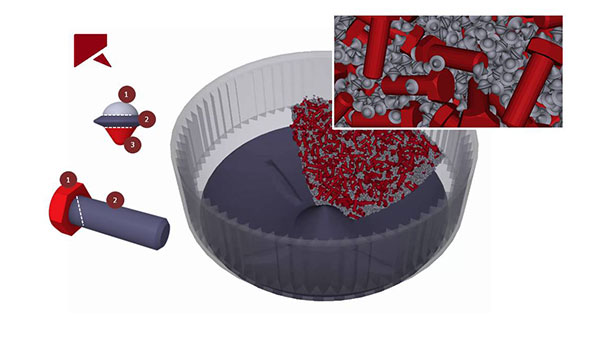Rocky 2022R1 Enables Industrial Scalability of Processes
The new particle dynamics modeling software, Rocky 2022R1, enables particle dynamics simulations with larger numbers of particles, company reports.

Simulation of bolt finishing equipment using the Particle Assembly model runs faster with less memory. Image courtesy of ESSS.
Latest News
April 8, 2022
ESSS released its particle dynamics modeling software, Rocky 2022R1. This release enables particle dynamics simulations with larger numbers of particles while offering tighter integration with other physics, company reports.
Engineers can access a science-based material calibration platform, and can accelerate simulation faster by using a Multi-zone Dynamic Domain. Particle-laden free surface flows can be simulated using a new multi-CPU and a multi-GPU SPH-DEM coupled solver.
“The release of Rocky 2022R1 is another installment of delivering our vision to solve all types of engineering problems involving discrete solids, with the solution timeframe, capabilities and usability required by engineers,” says Clovis Maliska Jr., ESSS CEO.
The 2022R1 Material Wizard complements Rocky’s calibration suite and is designed to advance Rocky simulations by turning real-world material information into ready-to-use setup parameters. The Wizard compares experimental data with a built-in material database and uses artificial intelligence and machine learning techniques to provide required material-related simulation parameters.
The Wizard is fully customizable and configurable to individual applications or groups of materials and can be downloaded directly from Rocky’s customer portal.
The Multi-zone Dynamic Domain enables faster simulation, allowing ability to simulate applications with several millions of particles by reducing memory requirements and speeding computational time. This simulation optimization methodology enables dynamic calculation zones of interest to include or minimize contact detection inside or outside of the zones, based on where the particles are active.
The current Rocky release enables assembling of different particles to form new shapes. The Particle Assembly model improves computational performance for complex concave shape particles and enables simulation of limitless discrete particle shapes.
Another capability in the 2022R1 release is the introduction of a bond model that extends Rocky’s advantage in modeling particle breakage. This new model simulates the behavior of material represented as a collection of bonded particles of any shape.
Rocky is launching the beta version of its native SPH-DEM solver kernel with a focus on particle-laden free surface flows. The solver is developed native to multi-GPUs and multi-CPUs. The SPH-DEM coupling offers a simulation approach for slurry flows, for example. The solution methodology efficiently accounts for the presence of different sized and shaped particles as well as fluid-particle interaction.
The 2022R1 release extends Rocky’s applications of Ansys CFD coupling that involve particle size changes due to mass and heat transfer (conduction, convection, and radiation) with or without chemical reactions. The effect of particle size changes can be used in particle drying, particle gasification, and pyrolysis.
Click here for a video of the product highlights.
Sources: Press materials received from the company and additional information gleaned from the company’s website.
Subscribe to our FREE magazine, FREE email newsletters or both!
Latest News
About the Author
DE’s editors contribute news and new product announcements to Digital Engineering.
Press releases may be sent to them via [email protected].
Related Topics





